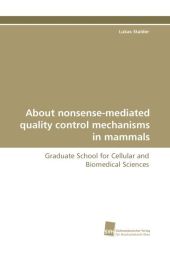 Neuerscheinungen 2010Stand: 2020-01-07 |
Schnellsuche
ISBN/Stichwort/Autor
|
Herderstraße 10
10625 Berlin
Tel.: 030 315 714 16
Fax 030 315 714 14
info@buchspektrum.de |

Lukas Stalder
About nonsense-mediated quality control mechanisms in mammals
Graduate School for Cellular and Biomedical Sciences
2010. 104 S.
Verlag/Jahr: SÜDWESTDEUTSCHER VERLAG FÜR HOCHSCHULSCHRIFTEN 2010
ISBN: 3-8381-1317-9 (3838113179)
Neue ISBN: 978-3-8381-1317-3 (9783838113173)
Preis und Lieferzeit: Bitte klicken
In order to assure the high accuracy of gene expression, eukaryotes have evolved diverse quality- control mechanisms that recognize and degrade messenger RNAs (mRNAs) that fail to encode a complete and functional protein. Nonsense-mediated mRNA decay (NMD) recognizes and degrades mRNAs that harbor a premature translation termination codon (PTC). Yet, the molecular mechanism of NMD is not solved. A central step is the distinction of a PTC from a normal translation termination codon. We found that normal mRNAs can be turned into an NMD substrate by elongating the 3 untranslated region (3 UTR) in mammalian cells. Furthermore, PTC- containing mRNAs can be stabilized by bringing the poly(A) tail in close spatial proximity of the PTC, and consistently, PTC-containing mRNAs are stabilized by tethering of poly(A)-binding protein. Together with studies performed in other eukaryotes, we propose an evolutionary conserved, unified model for PTC recognition. Most importantly, these results demonstrate that spatial rearrangements of the 3 UTR can modulate the NMD pathway and thereby provide a novel mechanism for posttranscriptional gene regulation.
Lukas Stalder, Dr. phil.-nat.: Master of Science in Biochemistry in 2005 at the University of Bern. PhD in Molecular Biology in 2008 at the Institute of Cell Biology in Bern. Currently Postdoctoral Fellow at Novartis Pharma AG.


